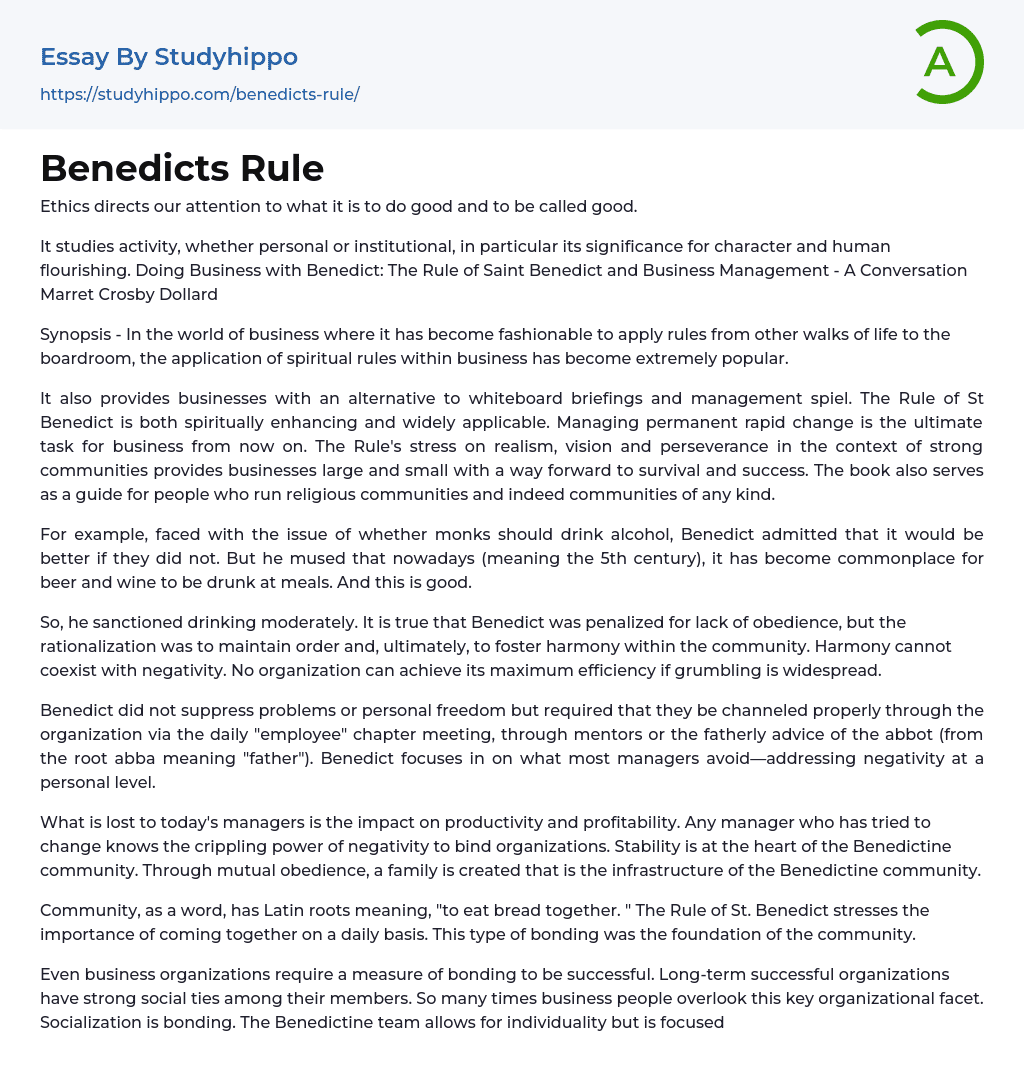Ethics directs our attention to what it is to do good and to be called good.
It studies activity, whether personal or institutional, in particular its significance for character and human flourishing. Doing Business with Benedict: The Rule of Saint Benedict and Business Management - A Conversation Marret Crosby Dollard
Synopsis - In the world of business where it has become fashionable to apply rules from other walks of life to the boardroom, the application of spiritual rules within business has become extremely popular.
It also provides businesses with an alternative to whiteboard briefings and management spiel. The Rule of St Benedict is both spiritually enhancing and widely applicable. Managing permanent rapid change is the ultimate task for business from now on. The Rule's stress on realism, vision and perseverance in the context of strong communiti
...es provides businesses large and small with a way forward to survival and success. The book also serves as a guide for people who run religious communities and indeed communities of any kind.
For example, faced with the issue of whether monks should drink alcohol, Benedict admitted that it would be better if they did not. But he mused that nowadays (meaning the 5th century), it has become commonplace for beer and wine to be drunk at meals. And this is good.
So, he sanctioned drinking moderately. It is true that Benedict was penalized for lack of obedience, but the rationalization was to maintain order and, ultimately, to foster harmony within the community. Harmony cannot coexist with negativity. No organization can achieve its maximum efficiency if grumbling is widespread.
Benedict did not suppress problems or personal freedom but required that they b
channeled properly through the organization via the daily "employee" chapter meeting, through mentors or the fatherly advice of the abbot (from the root abba meaning "father"). Benedict focuses in on what most managers avoid—addressing negativity at a personal level.
What is lost to today's managers is the impact on productivity and profitability. Any manager who has tried to change knows the crippling power of negativity to bind organizations. Stability is at the heart of the Benedictine community. Through mutual obedience, a family is created that is the infrastructure of the Benedictine community.
Community, as a word, has Latin roots meaning, "to eat bread together. " The Rule of St. Benedict stresses the importance of coming together on a daily basis. This type of bonding was the foundation of the community.
Even business organizations require a measure of bonding to be successful. Long-term successful organizations have strong social ties among their members. So many times business people overlook this key organizational facet. Socialization is bonding. The Benedictine team allows for individuality but is focused on the community. The virtue of humility is much lost today.
It does not suppress individual achievement but does suppress the use of achievement to control and use as power. Some of the greatest individual craftsmen arose from the Benedictine community. It is humility that gives the individual a perspective of self and a role to build community. Individual ideas are fostered, but ultimately the good of the community is the rule by individual choice. Another characteristic of Benedictine teams is that they equate to the community.
The push today is to form multiple teams within an organization, which actually can lead to a breakdown in
community and overall teamwork.
Benedictine teams are totally integrated using committees for more specific problem solving, employee involvement, and administration. Benedictine communities used the daily "team" or chapter meeting to focus on one rule, one community. Committees were used to involve employees and develop a specific focus on an issue. Committees were part of the community, not separate teams as we see in many of today's structures.
- Auction essays
- Balanced Scorecard essays
- Business Plans essays
- Expense essays
- Income essays
- Net Income essays
- Security Guard essays
- Singapore Airlines essays
- Battle essays
- Intranet essays
- Maintenance essays
- Simulation essays
- Inn essays
- Chief Executive Officer essays
- Convenience Store essays
- Firm essays
- Training And Development essays
- Unilever essays
- Variable Cost essays
- Virgin Group essays
- Bargaining essays
- Entity essays
- Pest analysis essays
- Leadership and Management essays
- Change Management essays
- Project Management essays
- Knowledge Management essays
- Operations Management essays
- Quality Management essays
- Risk Management essays
- Scientific Management essays
- supply chain management essays
- Performance Management essays
- Time Management essays
- Brand Management essays
- Total Quality Management essays
- Risk essays
- Manager essays
- Leadership essays
- Business Ethics essays
- Board Of Directors essays
- Product Management essays
- Comparative Analysis essays
- Decision Making essays
- Dispute Resolution essays
- Stress Management essays
- Business Management essays
- Brand Equity essays
- Branding essays
- Nike, Inc. essays




